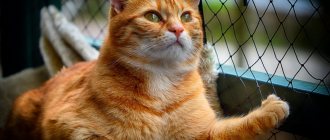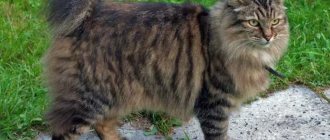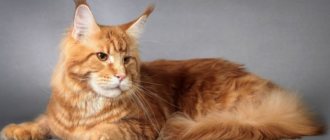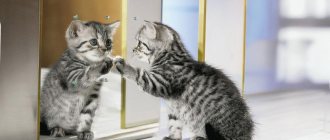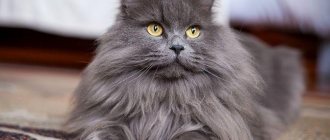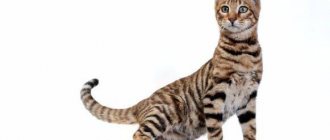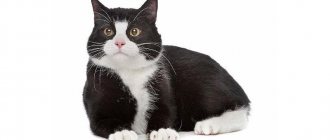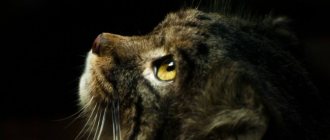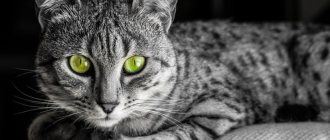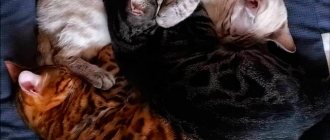How do you get brindle coat color?
Brindle or tabby mackerel is a subspecies of the tabby color. Cats with this pattern resemble miniature tigers. This color is a variation of the colors of cats found in the wild.
Many domestic cats have a ticking pattern called tabby. Ticking appears as a consequence of the dominance of the agouti gene. Each hair has light and dark stripes. Full pigmentation of hair that is in the growth phase is also possible. Then pigment synthesis slows down and resumes after some time. When the hair reaches its full length, pigment synthesis is complete. As a result, the hairs have dark pigmentation at the tips, then there is a yellow or orange stripe, followed by a dark area, and again yellow or orange. It turns out to be a kind of “striped flight”.
Interestingly, genetically the brown tabby is a black color, but as a result of selecting individuals with a pronounced red color, it was possible to obtain a dense brown tone in the ticked hairs.
The tabby color is determined by the gene (T), which causes the appearance of spots and stripes of the main tone on the ticked coat.
Commonly known tabby types:
- Tiger tabby - striped hairs are located on the main background (like a tiger).
- Classic tabby - ticked hairs appear in patches on the sides or back.
- Ticked Tabby (Agouti or Abyssinian) - The ticked hairs are evenly spaced and give the coat a freckled appearance.
- Spotted Tabby - The main background has ticked hair, spots or rosettes (like a leopard or jaguar).
The spotted tabby is not classified as a separate genotype. Scientists have not yet figured out the nature of the origin of the spotted tabby. Whether it can be considered a mutation of the tabby gene or is it just a polygenetic modification of the brindle tabby is not yet clear. Spotted tabby is observed in different species of wild cats and indicates an independent gene mutation. However, in practice, the spotted tabby produces offspring with spotted and striped patterns, so breeders always choose sires with clear spots, otherwise the pattern tends to shift to brindle.
Tortoiseshell cats also have a tabby pattern. In a tortoiseshell tabby, the pattern appears in the black and red areas. Solid and ticked stripes on a red background fade smoothly into black areas.
Savannah
A relatively new breed that was recognized by the Cat Fanciers' Association in 2012, the Savannah is known for its unusual appearance. Large, tall ears are located on the top of the head. The savanna is also characterized by a long neck, long legs and a short, thick tail. In addition, these cats have exotic spotted and striped coats. And this is not surprising, the wild appearance of the savannah was achieved by crossing the African serval with a domestic cat.
Conditions for keeping
Keeping brindle cats is not burdensome. Short-haired animals are combed once a week with a rubber mitten. Scottish and British cats have a thick undercoat that actively sheds twice a year, so the animals need to be brushed more often. A furminator can handle this task. The same rule applies to Siberian cats. Their luxurious fluffy coat sheds profusely in the spring and during the heating season. Tools such as a slicker and the same furminator will come to the rescue.
Breeders recommend giving the cat its own corner in the house, placing a house or bed there, as well as a scratching post. In addition, animals are given a place to litter and eat.
Bath days are organized twice a year. However, you should also remember that most cats are not happy about bathing. For example, the Scots and British are afraid of water like fire, but toygers and begals, on the contrary, love to swim. Therefore, it is important to take into account the characteristics of each breed and not force your pet.
The diet is selected depending on the breed, taking into account the recommendations of veterinarians.
Toygers inherited good health from their ancestors and experts do not give any special recommendations on nutrition.
Bengals should be fed natural high-protein foods or premium dry and wet food.
Tender Sokoke require a balanced diet fortified with taurine and vitamin E due to heart problems and metabolic disorders.
Mau are prone to allergies, asthma and heart disease, so they need special fortified food. Pet stores have lines of dry and wet food with a balanced composition that can maintain animal health.
It is recommended to feed Savannah with natural products: beef, poultry, ocean white fish, and give dry food as an addition to the main diet.
American Shorthairs, Scottish Shorthairs and British Shorthairs love to eat and are prone to weight gain. Therefore, animals need to be fed twice a day, and periodically pampered with boiled chicken breast.
Siberian cats need a balanced diet. For 1 kg of weight they give 30-60 g of feed. To maintain the beauty of their coat, cats under 3 years of age are given food containing 70% protein.
Price
The tabby color is relatively rare, so “tiger breed” cats are not cheap. The price varies depending on the intensity of color, exclusivity of pattern, breed and pedigree. Experts determine whether the kitten belongs to existing standards.
- Pet class (large deviations from the standard).
- Breed class (minor deviations).
- Show class.
The most expensive are Tigers - up to 120,000 thousand rubles, Scottish Folds - up to 25 thousand rubles, British - up to 10,000 thousand rubles.
And one last thing. If you decide to have a striped friend, remember that these animals really need your attention and love. Don't let them become aggressive and withdrawn.
Character of domestic "tigers"
The character of a brindle cat is as varied as the patterns on the animal’s skin. Representatives of cats are emotional, which is immediately noticeable by the expression of their eyes and muzzle. They are very active, adapt quickly, inquisitive and intelligent.
The hunter's instinct manifests itself in a constant search for game; sometimes the animal stores food for future use. Night movement around the apartment is dictated by nature's inherent need for safety.
But not all cats have this character. Some breeds, such as the Scots and the British, are very calm and even-tempered. Before purchasing an animal, be sure to consult the breeder. He will tell you about all the features of the breed and the character of the kitten you have chosen.
British and American breeds
The brindle color of the British cat attracts many breeders. Representatives of this breed have an obstinate character and the appearance of a fabulous Cheshire cat. The animal requires a lot of free space for constant movement and a separate place for privacy. The purchase price at the nursery is about 10 thousand rubles.
The American Shorthair is an active and strong cat, ready to jump and play all day long. Tiger stripes can be any color. Long-lived among domestic cat species.
Additional care
Artificially created varieties of the tiger breed are highly prized. Genetic studies prove a direct connection between the genes responsible for body color and the animal’s immunity. Selected cat breeds, despite the fact that their wild counterparts have excellent immunity, require additional attention to the nutrition and care of the pet.
The need for annual vaccinations and additional vitamins is mandatory for valuable representatives of the feline class. Monitoring the health of the eyes, heart and blood vessels will allow timely prevention of possible disease.
Representatives of many tiger breeds are long-lived; their lifespan is about 20 years with proper nutrition and lifestyle. The need for walks in the fresh air obliges the owner to think through ways and times for such activities.
Pixie bob
To develop a breed of cat that resembles a lynx, breeders used short-tailed forest cats. These animals live in the forests of North America. The first cat obtained in this way was named Pixie, which means “Elf” or “Fairy” in English.
The animals are distinguished by a short tail, tufts on the ears and whiskers are possible. Pixies are unpretentious, train well and easily make contact with people.
Health
Typically, wild-type animals are very resilient and disease-resistant, unlike their bred counterparts. Modern genetic studies have shown that the T gene, which determines the brindle color, is directly related to immunity.
We invite you to read: The main difference between food for sterilized cats and regular food: how to choose
Artificially created breeds, more than the descendants of their “wild” counterparts, are susceptible to diseases such as:
- cardiomyopathy;
- cardiac hypotrophy;
- cataract;
- feline leukemia.
The rest of the “tiger cubs” mostly suffer only from the same diseases that ordinary domestic cats suffer from:
- colds;
- infections;
- poisoning
Basic moments
- The name “toyger” is formed by merging two English words: toy - toy and tiger - tiger.
- Representatives of this breed are smart cats who are quite trainable. They quickly get used to walking on a harness and are able to perform simple acrobatic acts.
- Toygers are tigers only in appearance. By nature, these are quite peaceful and good-natured cats, always ready to join in the game proposed by the owner.
- This is one of the easiest breeds to care for. Toygers shed at a very sluggish pace, which frees the owner from the need to constantly comb the pet and endlessly vacuum the apartment.
- Toygers have no problems with obedience, but if the cat doesn’t like something, he will definitely express his own opinion with a loud meow. As an example: the breed does not like carrier bags and, once inside, the toyger will certainly try to notify others about the infringement of his rights.
- It is believed that the hunting instincts of cats are muted, however, it will not work to make friends with a toyger with a hamster or parrot.
- Toygers do not have a congenital fear of hydrophobia. This is one of those rare breeds for which going to the bathroom is not a tragedy, but an ordinary hygienic procedure.
- Toygers become sexually mature cats at the age of five months, while the psychological and physical maturation of animals is completed only by two years.
A toyger is about five kilograms of striped charm and playfulness that you can’t help but fall in love with. Despite their close relationship with independent Bengals, tiger cats did not resemble their relatives in character. Non-conflict, balanced, sincerely attached to people and home, toygers have every right to be considered, if not ideal, then completely problem-free pets. The breed has only one drawback - the excessive popularity of its representatives among animal lovers. And since increased demand does not always give rise to a high-quality supply, it is still easy to purchase a mixed breed or an unsuccessful breeding product with a lot of external defects under the “domestic tiger” brand.
Is it worth taking home stray cats?
The world is not without kind people, and the ever-decreasing population of stray animals always needs human help. The number of outbred cats in homes is several times higher than the number of their well-bred counterparts.
Veterinary experts consider three motives for which people take outdoor cats into their homes:
- compassion and desire to reduce the number of suffering animals;
- You don’t have to pay for a street kitten;
- a variety of types of feline “mongrels”, among which there is always a type suitable for “adoption”.
It has been noted that representatives of the yard cat breed almost never end up on the street again. People take full responsibility for the life of a stray animal and treat it with the same care as they treat expensive elite breeds.
Most often we are talking about yard kittens - in adulthood, animals are much less likely to find a new home.
Asian tabby
The brindle pattern is found among both short-haired and long-haired felines.
The Asian tabby cat is an animal with an exotic tiger color. The color of the coat can reach gray and silver shades, not at all reminiscent of its predatory counterpart. The formation of kittens' coloration can take from several weeks to two to three months. Purchasing an expensive friend is only possible at a specialized breeding farm upon pre-order.
The cost of a pet depends on the pedigree history, color contrast and characteristic pattern. Belonging to a certain class determines the final price. Pet class with differences from the standard color is estimated at 15-30 thousand rubles, Brit class with minimal errors in the standard - from 30-40 without the right and up to 60-70 thousand with the right to further breeding. Show class is a brindle cat with an ideal pattern and the right to breed. It costs from 80 thousand.
On her neck there is a spot - a necklace, and her eyes and nose with mouth are also outlined. The tail is tapered, with ring-shaped spots.
Painting comes with 4 types of patterns:
- spotted;
- marble (with stripes and stains);
- brindle;
- ticked (with a pattern on the face and striped hairs on the body).
Colors range from blue to cream and chocolate. The ears are erect, the eyes are almond-shaped, the irises are golden, and there are cheekbones. The character is friendly, gentle, communicates with people and other inhabitants of the house.
Leopard-colored cats are a mixture of various breeds, including wild ones. The most important thing in communicating with them is to try to find mutual understanding. A close study of your pet will help you find a common language and create comfort for everyone.
Sokoke. Description of the breed and its representatives
Medium sized Sokoke cat with marbled tabby pattern on a sandy background. The ears are large with tassels. The slanted look gives an original expression to the face of the graceful representative of the Kenyan forests. Sokoke is the forest African ancestor of Asian cats. The breed was registered in 1993. A distinctive feature of the tiger cat's coloring is the presence of a necklace around its neck. The color of the skin, similar to the bark of a tree, makes it distinguishable from other subspecies.
A miniature copy of a cheetah has a restless character and irrepressible energy. Strong attachment to the owners and playfulness will make the pet unhappy if its owners are constantly absent or busy with work. Sokoke is ready to play around the clock, which is suitable for families with small children. Hide and seek, chasing and constant movement around the apartment are what an active animal needs. African origin makes itself felt with the onset of cold weather, which is difficult for this heat-loving breed to tolerate.
Interesting photo
Calm grace
Yes, it's a tiger, just a small one
After games you need to rest
Before the jump
Handsome Toyger on a green background
Nutrition
The diet of a domestic predator should be varied, it includes meat and lactic acid products, vegetables, and vitamin supplements. Unable to tolerate a monotonous diet due to their being natural hunters, tiger individuals consume only fresh, nutritious food. Long-haired cats that undergo seasonal shedding require additional care. Frequent bathing is not particularly recommended; animals clean their own fur.
Striped felines have become so close to humans that life without them becomes boring and uninteresting. But it’s not always worth “chasing” a breed. Any stray cat can turn into a gorgeous, handsome cat, feeling the care and affection of its owner.
Scottish cat and munchkin
Scottish brindle cats are characterized by a marbled tabby color on the back and a large M-shaped mark on the forehead. Yellow eyes and small ears characterize this breed. It is estimated at an average of 25 thousand rubles.
The short-legged munchkin is often found with striped coloring. The shades of his stripes come in different colors. Very active and playful, loves to be in the company of small children. Its short legs make it look like a dachshund. This breed has been known since the 90s. You can purchase it from a farm for breeding animals at a price ranging from 5 to 20 thousand rubles.
Bengal and Egyptian Mau
The Bengal breed was the result of artificial mating of a wild leopard cat with outbred Californian cats in 1963. The breed was registered in 1983 and is more common than the Toyger.
Egyptian Mau are spectacular cats with short hair and slender legs, with the grace of a queen and large eyes. The four subspecies include smoke and silver with black spots, honey and sand with brown leopard patterns.
When a sacred pet died in ancient Egypt, it was buried with honors in the family crypt or in a separate animal cemetery. The embalmed feline was accompanied to another world by mummified mice.
